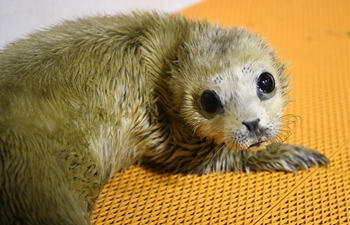ADDIS ABABA, April 4 (Xinhua) -- Ethiopian experts in the leather and footwear sector on Thursday hailed a Chinese-built research center, the first of its kind in Ethiopia, as an important boost to the country's ambition in modernizing related products.
The Ethiopia-China Joint Laboratory at the Ethiopian Leather Industry Development Institute (LIDI) was built by a team of Chinese experts with high-end Chinese technologies from the Chinese Leather and Footwear Industrial Research Institute (CLFI).
The joint laboratory, which mainly embraced a tannery wastewater treatment plant, was designed to provide Ethiopian researchers with the latest laboratory technologies as the East African country aspires to fully exploit its abundant cattle population, LIDI officials told Xinhua on Thursday.
Zerfie Mersha, Director of Environmental Technology Directorate at LIDI, told Xinhua on Thursday that the newly constructed tannery wastewater plant is a new technology that effectively treats wastewater without biological treatment.
The joint laboratory, which has been operational for the past one year period in the premises of LIDI on the outskirt of the Ethiopian capital Addis Ababa, "is now considered as a prime research and excellence center for aspiring Ethiopian experts in the leather development sector," Mersha said.
"The center could be seen as a model initiative to drive the ongoing momentum with new prospects in our engagement towards modernizing the leather and footwear sector," Mersha said, as she described various ongoing researches that are underway with the help of Chinese technologies that are operational at the center.
The center came to reality after an agreement that was signed among officials of the Ethiopian and Chinese ministries of science and technology back in 2013.
In addition to constructing the laboratory, Chinese experts had also provided various trainings for their Ethiopian counterparts on the utilization of modern technological outputs in tannery wastewater treatment sector, according to LIDI.
According to LIDI, construction of the joint laboratory is more vital as Ethiopia, which is home to one of the largest livestock populations in Africa, recently envisaged to spur value addition in the sector.
According to figures from the UN Development Program (UNDP), the East African country is endowed with an estimated more than 56 million heads of cattle, and 50 million heads of goats and sheep.
Despite Ethiopia's abundant livestock population, various experts and analysts often indicate that the country has not been able to fully harness its resources, to which a lack of modern technology is said to be a major bottleneck.
The institute, which aspires to see a growth of the East African country's leather industry in the global market share by 2023.
According to Bethlehem Haile, the Chinese-built modern research center has set a new direction toward filling the gap in utilizing modern technologies.
"Various students and researchers have now devoted their time at the plant with an aim to create new ways of modernizing the sector," Haile told Xinhua.
"It (the joint laboratory) is indeed a model intervention with much promising advantage to the sector's overall development through new innovations," she added.
LIDI, which engages various stakeholders towards the expansion of Ethiopia's leather industry sector through the promotion of investments and technological excellence in the sector, is a major partner of the Chinese CLFI.
Mersha, who noted the "huge potential" of China in Ethiopia's efforts to modernize the leather industry sector, said that some 20 experts from the institute were in China recently to learn new technological advancements in the sector as well as to further observe China's leather and footwear sector.













